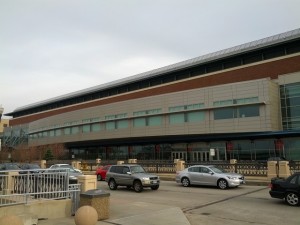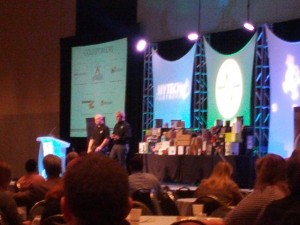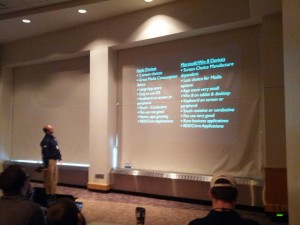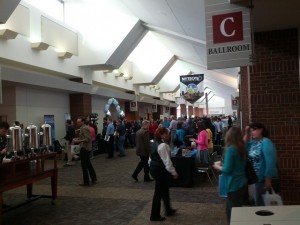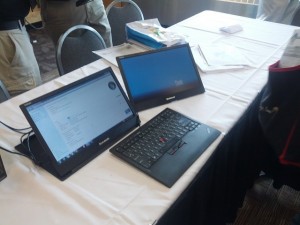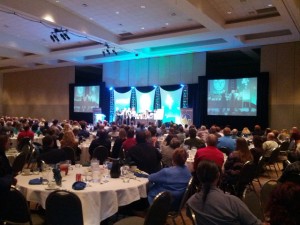Good morning, everyone! It’s a cloudy, yet warm morning here in St. Paul, Minnesota! I will be at the River Centre in St. Paul today, covering this year’s TechPulse 2013 event! TechPulse is a technology based conference that is held annually in St. Paul, covering the latest IT technologies for small business and enterprise usage.
Stay tuned for updates throughout the day!
8:30 AM – 9:15 AM: Welcome Presentation
Welcome presentation begins with two speakers, introducing TechPulse 2013, discussing today’s breakout sessions and the end of the day prizes. The speakers also discussed about the challenges IT firms face these days and presented several topographical charts of current and future IT infrastructures.
9:15 – 9:30 AM: Break
The TechPulse staff had issues with printing out name tags this morning, but after getting registered, I was able to pick up my tag without issue. Checked out a few booths, such as Dell, D-Link, Belkin, and Microsoft. Dell’s booth mostly centered on their enterprise solutions, cloud computing, SonicWall Firewall solutions, etc. Microsoft’s booth was a bit sparse, with a MS Surface device on display. D-Link’s booth was a bit more interesting, presenting a lot of different IP and video security products. As for Belkin, they had a few network technologies on display, such as their router lineup.
9:30 – 10:15: Welcome to the Paradigm of Tablet Computing
Speaker: Jeffrey Funk | Lenovo
Jeffrey Funk opened the session by discussing about the wide range of tablets of different configurations, such as platforms, interfaces, screen sizes, applications, etc. He focused on the implications of tablets in an IT environment and brought up five questions:
* What will be supported? (integration, security, support)
* What will be the primary use? (device strengths, transferable experience)
* What is the ideal screen size? (ergonomic, viewing size, work space)
* What are the primary applications? (primary use., native app, app choices)
* What is the main interaction? (keyboard, pen, capacitive touch)
With these questions, Jeffrey focused on the strengths of tablets and the beneficial roles that they could play in the workplace.
10:15 – 10:30 AM: Break
After the first session, I visited some more booths, such as WatchGuard, which had several interesting hardware security routers on display. There were also some non-tech booths available, such as Wildlife Preservation and autism-related booths.
10:30 – 11:15 AM: Securing Networks in a Virtual, Cloudy World
Speaker: Corey Nachreiner | WatchGuard
Corey Nachreiner began the session by giving a presentation quick history overview of virtualization and where it is today. He discussed about the common virtualization platforms and the typical virtualization infrastructures found in IT environments these days.
Corey then stressed the importance of securing virtualization platforms and how much of these platforms are not being secured properly. He cited different examples of highly publicized exploits, such as the Zeus bot network and the Sony PSN security breach and how hackers took advantage of virtualization platforms for their malicious attacks. He noted that with the rise of Web 2.0 platforms and applications, the risk of web security exploits are higher than ever.
An example Web 2.0 web attack on a virtualized platform was then demoed. Corey ran three VMs (Windows 7, Back Track 5rd Linux distro, and Linux terminal) and used an XSS exploit on a fake social media website to demonstrate how a cross-browser attack works in the background.
Afterwords, Corey discussed several ways of securing virtualization platforms, such as keeping hypervisors updated, and applying common practice server security approaches on VMs.
11:15 – 11:30 AM: Break
I checked out the Lenovo booth, where they had several of their ThinkCentre workstations and ThinkPad laptops and tablets on display.
11:30 – 12:15 PM: Iterative Website Development
Speakers: Charles Goodman & Dan Feller | Plaudit Design
As I am currently transitioning from an IT role to more of a mobile/web developer role, I decided to attend the Iterative Website Development session, presented by Charles Goodman & Dan Feller from Plaudit Design. The session was much more marketing-orientated rather than developer-orientated, but still a great session, as Charles and Dan covered a lot of great ideas that companies should be doing for their website marketing.
The following below is an outline of what the session covered:
- Introduction to Iterative Website Development
- Web Site Approaches
- Stagnant
- Business misrepresented.
- Outdated technology.
- Doesn’t fulfill audience needs.
- Results in an eventual costly overhaul.
- Active
- Accurate representation.
- Takes advantage of technology.
- Fulfills audience needs.
- Spreads out expenses and delivers results faster.
- Iterative Methodology
- Opportunity -> Brainstorm -> Plan -> Implement -> Measure
- Benefits
- Less investments with time and money.
- Easer to measure small changes.
- Easier to plan and manage small changes vs. ramifications of modifying an entire site at once.
- Search engine optimization (SEO) benefits.
- When Full Redesign is Appropriate
- Web design out of date.
- Website tech is old, unusable, phased out.
- Website does not meet business needs or does not reflect company.
- Types of Changes (Branding / Design)
- Logo.
- Colors.
- Fonts.
- Photography.
- Minor stylistic changes.
- Layout adjustments.
- Structure and content.
- Adding, removing, and moving content sections/categories.
- Content – Copy and messages.
- Functionality and Experience
- Improvements to specific elements.
- Adding a new interactive element.
- Upgrading technology as the web evolves.
- Process
- Sholom iterative website example.
- Step 1: Identify Opportunity
- Analytic data.
- Feedback or surveys.
- External inspiration.
- Step 2: Brainstorm Solutions
- Research possible causes / improvements.
- Analyze.
- Generate a list of ideas.
- Select implementation(s).
- Step 3: Plan
- Outline implementation.
- Define how to measure success.
- Gather resources (e.g. content).
- Create a schedule.
- Step 4: Implement
- Design.
- Develop.
- Review.
- Launch.
- Step 5: Measure Results.
- Use analytics and context.
- Determine if goals were met.
- Adjust your theory.
- Analyze Results
- Google Analytics.
- Survey Results.
- Parallel Design Model (A/B Testing)
- Advanced testing method.
- Applies to any type of update.
- Applies to any size of update.
- Solves implementation debates.
- Great for optimizing user experience.
- Website needs to be consistently updated.
- Tips
- Improve existing material.
- Start small.
- Define goals and measure.
- Intuition is important when theorizing, but trust your data.
- Balance data and context.
Off to lunch!
12:15 – 2:00 PM: Lunch & Keynote Speakers
The lunch provided at TechPulse was pretty formal, as we were served a full course meal, which included a Ceasar salad, a choice of Rosemary chicken breast, steak, or pasta, and a small dessert. While elaborate, the meal itself wasn’t anything to write home about, but was a nice experience nonetheless, as it allowed for the ability to chit-chat with other TechPulse visitors that were seated at our table.
During lunch, a presentation on improvisation in the workplace was given by three keynote speakers: Mark Bergren, Molly Cox, and Jim Detmar. These three individuals are the authors behind “Improvise This!: How to Think on Your Feet so You Don’t Fall on Your Face“, a book which is devoted to introducing improvisation to the workplace to achieve dramatic changes in the workplace and life in general. They spoke about several different aspects of improvisation and performed live skits to demonstrate such techniques. The speakers invited several people from the audience to participate in the improv activities, resulting in some humorous skits.
2:00 – 2:15 PM: Break
Before the final breakout session, I deposited all the lottery tickets (for the prize giveaway event at the end of TechPulse) and took the opportunity to visit a few more booths.
FRSecure had an interesting laptop hacking demo setup at their booth, as they demonstrated that they could bypass a password secured login screen in Windows 7 using available hacking scripts available online. The demonstrator loaded the exploit on the USB drive, restarted the laptop, and booted directly to the USB drive to load the script. Once loaded, the demonstrator used the available options in the script to wipe out the Administrator password and was able to login into the Windows 7 partition easily after performing the exploit. Their main point was that without encrypting the hard drive, it was possible to get access to laptop data, no matter how complex the password was.
2:15 – 3:00 PM: Basics of Network Infrastructure and Demystifying Wireless Design
Speaker: Dan Skrove | D-Link
In this session, Dan Skrove from D-Link discussed the basics of network and wireless infrastructures. He began with a brief history on networking technology, eventually leading into a discussion of different types of network switches that are commonly found in today’s workplace. Dan pointed out the differences between unmanaged and managed switches, as well as the pros and cons for each type of switch.
For the second half of the session, Dan discussed about the behavior of wireless networks, their frequencies, and interference issues typically found with them. The differences between 2.4 GHz and 5.0 GHz was discussed, as well as the recommended channels that should be utilized for an optimal Wi-Fi configuration. Dan also briefly touched upon PoE (Power Over Ethernet) technology, primarily focusing on technical specifications and the bandwidth found in PoE solutions.
On to the prize drawings!
3:00 – 3:45 PM: Closing & Prize Giveaway
Everyone gathered in the main conference room, in which the TechPulse presenters thanked TechPulse 2013 attendees. They then moved onto the prizes, which were numerous and included lucrative items such as 42″ LCD TVs, 27″ LCD monitors, 2 TB external drives, 3 TB external drives, Xbox360 Kinect kits, Xbox360 games, Fujifilm cameras, etc.
The presenters drew names from the lottery wheel that people had submitted their accumulated lottery tickets into. Although I was able to deposit ten tickets, my friend Joey amassed about forty tickets, dramatically increasing his chances for a prize. In the end, I was able to win a Fujifilm FinePix AX650 15 MP digital camera.
That concludes this year’s TechPulse 2013 event! I would like to thank the TechPulse organizers for putting together such a great technology-based event, as well as my friend Joey, who made me aware that such an event was taking place this week in St. Paul!
I will be uploading the recordings for the breakout sessions at a later date.

